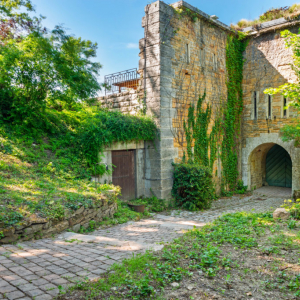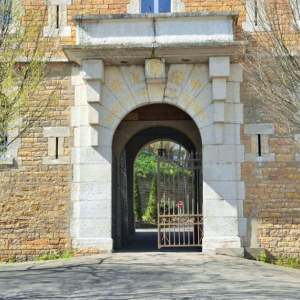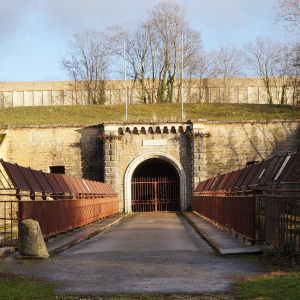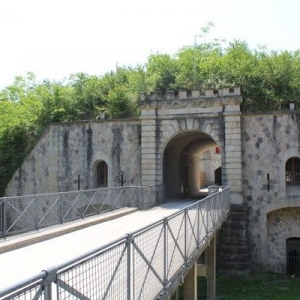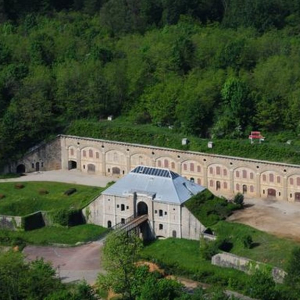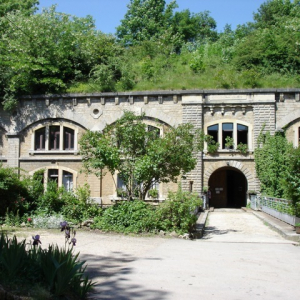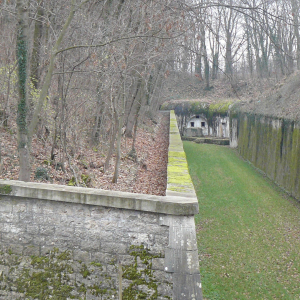- Discover
- Around Lyon
- Visit the Forts of Lyon and the surrounding areas
Visit the Forts of Lyon and the surrounding areas
A Heritage Trail
Bons plans
Last updated date : 23/01/2023
At the end of the 19th century, Greater Lyon had 33 forts, both in Lyon and the surrounding area. Though not all of them are still visible, some are open to the public for an experience that’s out of the ordinary!

See all pictures
Lyon's fortifications... a little history
Before the 19th century, Lyon had few fortifications and strongholds and the ones it had were badly maintained, which led to the city being occupied by Austrian troops in 1814 and 1815. At this unstable time, there was an urgent need to make Lyon a stronghold for the French Empire, in order to defend the south-eastern part of the country.
It wasn’t until the period from 1831 to 1854 that 19 forts were built in Lyon and its immediate surroundings: Montessuy, Caluire, Brotteaux, Montluc, La Motte, La Part-Dieu, La Vitriolerie, Ste-Foy, La Duchère, St Irénée, Loyasse and Vaise.
After the war of 1870, General Séré de Rivières came up with ideas to rework France's defence systems and wanted to set up a second ring of defences further out from Lyon, known as the second belt, to compensate for the increase in artillery range and the growth of the city. Between 1874 and 1896, 14 forts were built: Mont-Verdun, Le Paillet, Chapoly, Bruissin, Côte-Lorette, Montcorin, Champvillard, Feyzin, Corbas, St-Priest, Bron, Genas, Meyzieu and Vancia.
But the evolution of military techniques in the 20th century and the arrival of aviation quickly rendered them useless. Some of Lyon’s forts were therefore destroyed (the one in Les Brotteaux to build the old railway station, the one in Part-Dieu to build the shopping centre, etc.) and others were repurposed.
Today, some of these forts are open to the public, so we recommend you see them for yourself.
Fort de Vaise
Built to guard the North entrance to Lyon, above a bend in the river Saône, the fort de Vaise was part of the city’s first ring of defences in the 1830s.
Connected to the Fort de Loyasse by underground passages, it quickly became obsolete and was bought by Lyon city council in 1927. It was abandoned in 1965 and saved from demolition by the Renaud brothers, who restored it and set up a heritage conservation and cultural foundation there, which still hosts exhibitions and events today. The underground passages were cleared and opened up for guided tours by the association OCRA-Lyon in 2006.
Check out :
- The fort's underground passages
- The incredible view of the Saône
- The exhibitions
Fort de Vaise
27 boulevard Antoine de Saint-Exupéry - 69009 Lyon
Métro D stop Valmy then Bus 90 direction Sainte Foy Lès Lyon, stop « Fort de Vaise Les Carriers » (or a 10-minute walk from the metro)
Open for art events. You can find more information the website.
Fort Saint-Irénée
The fort Saint-Irénée, built between 1834 and 1842, was part of Lyon’s first belt of fortifications. Made of yellow Couzon stone, it incorporates five arches of the Gier Roman aqueduct and the start of a siphon to get the water across a dip in the land, the Dépression de Trion. At the time, it was made up of a pentagonal fort and a fortified barracks and was intended as the command post for the west sector of Lyon. By the 1960s, it was already outdated and was used mainly as an infantry barracks.
It was handed over to the university after the First World War, and from 1921 to 1951, it housed the Institut Franco-Chinois, the first Chinese university outside of China. Today, a cultural centre traces its unusual history. In 1955, the André-Allix university residence was set up there. Now you can see the fort from the outside, where the arches of the aqueduct are visible, and go inside the building’s courtyard to visit the Nouvel Institut Franco-Chinois.
Check out :
- The ruins of the Gier aqueduct
- Le Nouvel Institut Franco-Chinois
- The golden lettering above the entrance to the fort
Fort Saint-Irénée
2 rue Sœur Bouvier – 69005 Lyon
Bus C20E in Bellecour stop Saint-Irénée
Access to the outside of the fort and to the interior courtyard to visit the Nouvel Institut Franco-Chinois.
Fort de Bron
The fort de Bron as part of the city’s second belt of defences, was built between 1875 and 1877. It could house 841 people and 64 cannons in wartime.
In 1886, progress in artillery and the invention of a new type of explosive rendered the fort obsolete. Partially disarmed, it remained a major storage site. A military aviation school was set up nearby in 1912, with the fort housing the pupils. It was occupied in 1942 by the German occupying forces and became French again in September 1944. Decommissioned from military use in 1963, it was acquired by Greater Lyon council, then Bron council in 1981.
Check out :
- The caponiers
- The bakery
- The forge
Fort de Bron
Chemin Vieux - 69500 Bron
Tramway : T2-T5 stop les Alizé
Bus : C15 stop Fort de Bron
Open for guided tours only, free tours every month. More informations.
Fort de Feyzin
Built between 1875 and 1877, the fort de Feyzin was mostly used as a garrison for the army then the National Gendarmerie. Closed and forbidden to the public in the 20th century, it was acquired by Feyzin town council in 2003, who restored the 22,500 m2 space.
The fort, in a wood with a botanical trail, is one of the best examples of the ‘Séré de Rivières’ style: there is a single entrance accessed via a drawbridge over a ditch, with a pentagonal structure open onto the city to be defended.
Free guided tours are offered on the second Saturday of every month for visitors to (re)discover the areas of the Fort that are usually closed to the public. To register for one of these tours, open to anyone aged 5 and up, email [email protected]. For more information, visit the Fort de Feyzin website (in French).
Check out :
- The bakery for a tasty treat on the last Sunday of every month
- The stables, now a riding school
- The caponiers
Fort de Feyzin
8 rue du Docteur Jean Long - 69320 Feyzin
Bus 39 and 60 stop La Bégude à 800 m du fort
Open every day, specific opening days for the fort bakery and riding school. More informations.
Fort du Bruissin
Completed in 1881 (as the inscription over the entrance says), the fort du Bruissin was built to house 33 cannons and around 300 men. It has wooded grounds and is surrounded by imposing ditches.
Used as an ammunition depot in the First World War, it was then occupied by German troops at the end of the Second World War.
In 1979, it was acquired by Francheville council, who undertook considerable renovation works to enhance this exceptional historical site. The Fort is now a centre for visual and performing arts.
Check out :
- The entrance to the building
- The gunpowder magazines
- The heritage interpretation trail
Fort du Bruissin
Chemin du Château d’eau - 69340 Francheville
Bus C20E from Bellecour, stop fort du Bruissin
Not open to the public. For the arts event schedule.
Fort du Paillet
The Fort du Paillet, built between 1883 and 1886, immerses visitors in military history thanks to its excellent level of conservation. It has a layout typical of the forts built in the region at this time and could last three months without supplies from the outside. As well as the military equipment, you can see everything that made up the daily life of the garrison: kitchen, bakery, water cistern, well, etc.
Used as a storage depot during the First World War, it would go on to be occupied by the Germans in 1942 and was used to hold prisoners before they were sent to other camps. It was bought by Dardilly council in 1981 and is now home to various associations.
Check out :
- The barracks building
- The old kitchen
- The caponiers
Fort du Paillet
Chemin du Fort - 69570 Dardilly
Bus 3 in Gorge de Loup stop Dardilly Le Paillet
Tours on the first Saturday of every month, run by the Fort du Paillet association. For more informations.
Fort de Vancia
This fort, covered in vegetation, was part of Lyon’s second belt of defences and covers an area of 16,200m2. Today it is home to parc Vanciaventure, with a treetop adventure course, a commando assault course over the fort’s old obstacles and a terrifying escape game inside the halls of the fort.
Visit during the EHDs for traditional guided tours of the site.
Fort de Vancia
Fort de Vancia - 69140 Rillieux-la-Pape
Bus C5 in Cordeliers stop Fort de Vancia – Vancia le Bas
For more informations.
Fort de Saint-Priest
Built around 1888, the fort de Saint-Priest was intended to watch over the Plaine de l’Isère, the road to Grenoble and the ‘Lyon Bourgoin’ railway.
Decommissioned from military use in 1900, it was used a depot before being occupied during the Second World War. The German army exploded some of the munitions that they couldn’t take with them in 1944, damaging the fort.
It was bought by the city council in 1969 and the public can see it during the EHDs or contact the association La San-Priode to arrange a visit.
Fort de Saint-Priest
Fort de Saint-Priest 69800 Saint-Priest
Tramway T2 until Saint-Priest Hôtel de Ville then bus 50 stop Boris Vian from Saint-Priest Hôtel de Ville
For more informations.
Forts open for the European Heritage Days Only
There are some exclusive opportunities open to you on the third weekend of September. For the EHDs, the majority of the forts offer guided tours. It’s also an opportunity to see forts that are usually closed to the public!
